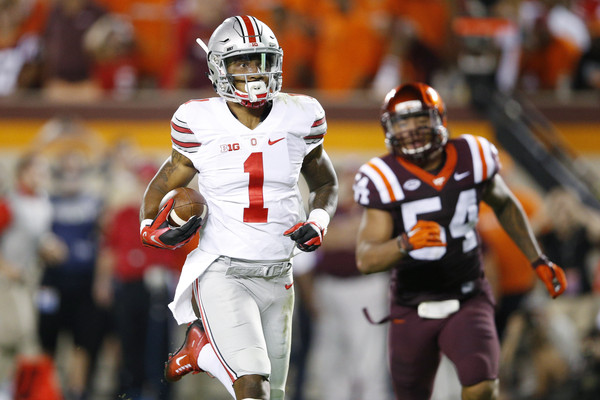What Did We Learn About the Big Ten in College Football Week One?
It was towards the tail-end of Ohio State’s 42-24 Labor Day Night win at Virginia Tech that ESPN put up a graphic showing the rest of the Buckeyes’ schedule and the % chance they had of losing each individual game the rest of the season. The worst rating that got was a 77% chance of winning against Michigan State.
There’s been plenty of talk about what that means for the College Football Playoff (e.g., that Ohio State is a lock). What I want to do is look at what this might tell us for handicapping the rest of the Big Ten, particularly with Michigan State being in the spotlight this Saturday night at home against Oregon (8 PM ET, ABC).
Put simply, is the Big Ten still prime “go-against” territory for handicappers in non-conference play? Let’s look at the record. In Week 1, the 13 Big Ten teams not located in Columbus went 7-6 ATS (against the spread). That sounds good enough—in handicapping any number over 52.4% is enough to beat the house advantage and that record clocks in at 53.8%. But digging deeper showed some problems.
Here’s a breakdown of the games in three categories—notable wins, notable losses, and games that we shouldn’t draw too many conclusions from…
NOTABLE WINS
- Northwestern (+10) Stanford 16-6
- Illinois (-13) Kent 52-3
- Minnesota (+16) TCU 17-23
NOTABLE LOSSES
- Penn State (-6) Temple 10-27
- Nebraska (-5) BYU 28-33—note that even had BYU’s desperation pass to win the game failed, the Cornhuskers would only have won 28-27 and thus failed to cover.
- Indiana (-20.5) Southern Illinois 48-47
- Purdue (+7) Marshall 31-41
- Michigan (+5) Utah 17-24
- Michigan State (-16.5) Western Michigan 37-24
WAIT AND SEE
- Wisconsin (+12) Alabama 17-35
- Iowa (-10) Illinois State 31-14
- Maryland (-21.5) Richmond 50-21
- Rutgers (-35) Norfolk State 63-13
In these “wait and see” games, the Big Ten went 3-1 against the spread. But the competition faced by Iowa, Maryland and Rutgers is not comparable to what any of these teams would face against even a midlevel opponent from a Power 5 conference. It’s not that there’s anything wrong what the three Big Ten teams did, just that we can’t take anything from it. On the flip side, it’s tough to be too hard on Wisconsin for ending up in Alabama’s way last Saturday night in Dallas.
Thus, if you remove these latter four games from the mix, the Big Ten’s non-Ohio State ATS record slips to 4-5. And frankly, you can probably make a case for throwing out Illinois’ win over Kent as non-representative.
That brings us to Michigan State, the next Big Ten team in a spotlight game. Amidst the conference’s focus last week on Ohio State and Wisconsin, and later the strong showing by Minnesota, the upset by Northwestern and the heartbreak in Nebraska, the Spartans got overlooked. And if you’re a Michigan State fan, that’s a good thing, because there was plenty to be concerned about.
Michigan State could not stop Western Michigan’s passing game. WMU quarterback Zach Terrell completed 33/50 passes for 365 yards, with wide receivers Corey Davis and Daniel Braverman consistently getting open. Michigan State’s calling card in recent years has been its defense. One of the big question marks about Sparty this season was whether they could replace departed coordinator Pat Narduzzi, now the head coach at Pitt. The early returns did not give reason for optimism.
If Michigan State is going to be the Big Ten’s prime challenger to Ohio State with these defensive problems, then it suggests real weakness down the conference, a weakness which is backed up by Week 1 results against legitimate competition.
I want to stress that claims such as this are not universal, in that they apply to every game. I could take a critical eye to Oregon and look at their 61-42 win over Eastern Washington and talk plenty about defensive problems. Both the Ducks and Spartans have issues and which way to play this game—if at all—is still something my staff and I have under discussion.
What I can tell you is that a key principle of handicapping is to identify ways to narrow down a big college card to select betworthy spots. One such way is to identify trends which point us to certain games, then dig deeper into those games and see if the matchup and the line is right. Adopting a skeptical attitude toward any Big Ten team not named Ohio State in a non-conference game of significance is such a trend.
Jim Hurley has been a successful public handicapper since 1985, when he began a Network that emphasized a team approach to handicapping. Hurley consults with statistical analysts, personnel experts and Vegas insiders to narrow the NFL and college cards down to the most bettable games each and every week. Visit him online at www.winningedge.com.

Thank you for your blog post. Thomas and I have already been saving to buy a new book on this subject and your post has
made people like us to save money. Your notions
really responded to all our concerns. In fact, greater than what we had thought of previous to the time we found your wonderful blog.
My spouse and i no longer have doubts and also a troubled mind
because you have attended to the needs in this article. Thanks http://www.daftarcf88vn.com
Football is most popular sport among high school and college students and they are having dream to play with school teams and order custom paper to make proud their school by goals against other school teams. Those reviews are interesting best of luck for all the teams.